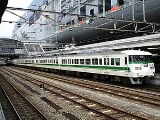
117 series
Encyclopedia
The is a Japanese suburban electric multiple unit
introduced in 1979 by Japanese National Railways
(JNR), and currently operated by Central Japan Railway Company
(JR Central) and West Japan Railway Company
(JR West). A total of 216 cars were manufactured. When JNR was privatized and divided into the individual JR Group companies, JR Central received 72 cars, while JR West took possession of 144.
trains that had been providing special rapid service in the Keihanshin region on the Tōkaidō Main Line
and Sanyō Main Line. 113 series cars were used in this role from 1972 along with 153 series express cars that been surplussed as a result of the opening of the Sanyō Shinkansen
to Okayama. Although 113 series cars were run in place of 153 series cars, the two were not entirely similar; the 153s had been retrofitted with air conditioning, but their traction motors (MT46 type, producing 100 kW @ 375 V), first built in 1958, were underpowered and the interior had box seats while cars run on competing services by the Hankyu Railway
and Keihan Railway had cross seats. And, as they were designed for express service, they had entryways which required passengers to step up onto the main floor—unsuitable during peak commuter times.
The 117 series addressed these issues, matched the passenger accommodations offered by competing services, and provided JNR with a train designed for the transit conditions in the Keihanshin region. The interior was based on the KiHa 66/67 series DMU
s being operated in the Kita Kyushu region. This also marked the beginning of JNR's effort to standardize their rolling stock.
In 1982, 153 series trains serving rapid service in the Nagoya area were replaced with 117 series trains which began duty on the Tokai Liner service.
On September 12, 1979, the first 6-car set emerged from Kawasaki Heavy Industries
' Hyōgo Works. After trial runs, it was displayed at Ōsaka, Kyōto, Kōbe, and Himeji on October 13 and 14. The sets' completion dates and manufacturers are as follows:
is the only other type to have this appearance.)
The 117's original livery was creme with a thin, horizontal maroon band below the windows. The history of this scheme includes the 52 series
Express trains as well as the 80 series trains built in the 1950s, and was chosen due to its fitting in with other liveries used by the Ōsaka Railway Administration. It had been a JNR rule that suburban train liveries were consistent from train to train based on their use of either AC or DC current, however the 117 series broke that rule. Later, the 105 series trains inaugurated the use of liveries based on region.
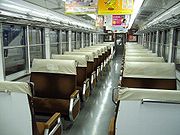 All 117 series cars were originally equipped with reversible cross seats, but lacked strap hangers. The interior had wood trim intended to set the 117 apart from other suburban trains. The cars feature flat ceilings joined to the walls an angled panel above the luggage rack. This method is the same as that used in the 781 series and 185 series, which first appeared around the same time as the 117. Prior examples include the 0 series Shinkansen and the Keisei Railway's AE series.
All 117 series cars were originally equipped with reversible cross seats, but lacked strap hangers. The interior had wood trim intended to set the 117 apart from other suburban trains. The cars feature flat ceilings joined to the walls an angled panel above the luggage rack. This method is the same as that used in the 781 series and 185 series, which first appeared around the same time as the 117. Prior examples include the 0 series Shinkansen and the Keisei Railway's AE series.
Air conditioning was via JNR's standard AU75B and AU75C units situated in the center of the roof (42,000kcal/h. B is used on trailer cars with driver's station, C on powered cars. 100 sub-series cars were upgraded to AU75E). Like on the 183 series, these units could also circulate fresh air.
, 6-car consists with four powered and two trailer cars were not quite as strong as those in use in comparable services by competing private railways. The difference in 4-car consists with only two powered cars was even more pronounced.
and 417 series, the 117 series included a retarder to maintain speed on an incline. While the CS12 control gear in the 113 series and 153 series and the CS15 control gear in the 115 series and 165 series had been improved to provide smoother acceleration, the CS43A, which was brand new at the time, was chosen.

and 223 series
were also so equipped.
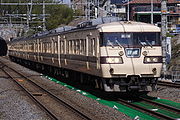 From 1979 until 1980, 21 6-car sets were produced for a total of 126 individual cars. Dispatched from Miyahara Depot and assigned to rapid and special rapid service, these were used to replace 153 series and 165 series trains.
From 1979 until 1980, 21 6-car sets were produced for a total of 126 individual cars. Dispatched from Miyahara Depot and assigned to rapid and special rapid service, these were used to replace 153 series and 165 series trains.
In 1982, nine 6-car sets entered service in the Nagoya area. These were assigned to Ōgaki Depot.

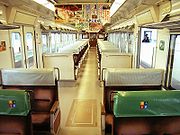 In the timetable effective November 1, 1986, just before the April 1987 privatization of JNR, the frequency of special rapid services in the Keihanshin region increased, and 6-car consists in the Nagoya area were shortened to 4 cars. It has been 4 years since any modifications were made, and around this time improvements were made to all aspects of the trains. The most significant changes were:
In the timetable effective November 1, 1986, just before the April 1987 privatization of JNR, the frequency of special rapid services in the Keihanshin region increased, and 6-car consists in the Nagoya area were shortened to 4 cars. It has been 4 years since any modifications were made, and around this time improvements were made to all aspects of the trains. The most significant changes were:
Following privatization, JR West kept the cars used in the Keihanshin region while JR Central kept those used in Nagoya. Each railway's use of their 117 series trains is explained below.
in the Keihanshin region, the maximum speed of special rapid trains was increased to 115 km/h (71.5 mph) as of the March 10, 1990, timetable. That year, all 117 series cars underwent improvement to their brakes to accommodate this new operating speed. As new 221 series cars entered service, there was an excess of 117 cars, and as the speed of most special rapid services was further increased to 120 km/h (74.6 mph), 117s were reassigned to other lines. The 300 subseries entered service on the Fukuchiyama Line
, while shortened consists began running on the Nara Line
, Kosei Line
, Kusatsu Line
, and on the Sanyō Main Line in the Okayama area on the Sunliner service. Cars which became surplus due to the shortened consists were converted into 115 series 3500 subseries. This was the first reduction in the number of 117 series cars.
117 series cars retained in special rapid service were used only in early morning and late night runs because of their 115 km/h limit and door configuration. With the appearance of the 223 series
in the May 11, 1999, timetable, capable of operating at 130 km/h (80.8 mph) between Nishi-Akashi
and Kusatsu
, 117 series trains were withdrawn from special rapid service. A year later, 221 series cars were also removed from this service.
Having first appeared on special rapid service, the number of these cars has dwindled, and there are now only two 6-car sets assigned to the Kyōto Depot. After the installation of toilets (in the KuHa117 cars) and modifications to meet barrier-free requirements, they are sometimes used for reserved groups. The headboard has had the JR logo removed, and appropriately displays 'special' in the event of non-standard revenue operation. On October 10, 2004, the headboard displayed 'Revival Special Rapid' for a one-day promotional return to special rapid service.
In 2000, due to use of the newer 221 series, some 117 series trains were withdrawn from Tambaji rapid service on the Fukuchiyama Line
and reassigned to Hineno Depot for operation on the Wakayama Line
. Again in 2001, 117 series cars were replaced by 221 series units on Miyako rapid service on the Nara Line. In 2005, 100 subseries intermediate cars were reassigned to the Shimonoseki Administrative Office, and later 2 sets of 300 subseries trains were also sent there to operate in the region on the Sanyō Main Line.
Due to repeated reassignment, many consists are a mixture of liveries and subseries.
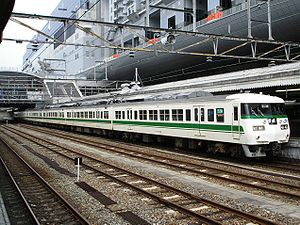
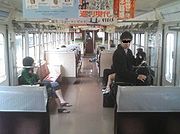 Having been displaced by the newer 221 series, from 1990 many of 117 series cars had been transferred to the Fukuchiyama Line. These cars retained their original numbers but had 300 appended to them. Through 1992, 1993, and 1995, a total of 58 cars were refurbished and reassigned to JR West's Miyahara Depot.
Having been displaced by the newer 221 series, from 1990 many of 117 series cars had been transferred to the Fukuchiyama Line. These cars retained their original numbers but had 300 appended to them. Through 1992, 1993, and 1995, a total of 58 cars were refurbished and reassigned to JR West's Miyahara Depot.
In order to increase the capacity of the cars and ease boarding and alighting, cross seats immediately inside the doors were converted to long seats. Up to this point, rush hour trains were being delayed due to the time needed for passengers to board and alight. Brakes were augmented, and the livery now associated with the Fukuchiyama Line, white with green striping, appeared. Some cars with the original seating arrangement still exist.
However, these modifications did not entirely solve the problems with passenger mobility during rush hour, and as a result, the 117-300s were used on outgoing services (bound for Fukuchiyama) and off-peak services. From April 2000, 2 4-car consists were dispatched from Hineno Depot for operation on the Wakayama Line and Kisei Main Line, and
Sets which remained on the Fukuchiyama Line until the series' complete withdrawal from the line are now assigned to Kyōto Depot for operation on the San'in Main Line
(Sagano Line
), Kosei Line, and Kusatsu Line, among others. Some consists have ATS-P train control onboard, others have MoHa cars surplussed by the creation of shorter 100 subseries sets.
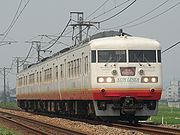 In 1992, six 4-car sets were reassigned to Okayama Depot. At this time, the lavatories were upgraded and the Sunliner livery appeared, and some of these sets operated at special rapid speeds of 115 km/h. In 1999, fare collection boxes were installed to support driver-only operation without a conductor on board. These consists were designated as:
In 1992, six 4-car sets were reassigned to Okayama Depot. At this time, the lavatories were upgraded and the Sunliner livery appeared, and some of these sets operated at special rapid speeds of 115 km/h. In 1999, fare collection boxes were installed to support driver-only operation without a conductor on board. These consists were designated as:
Later, three 4-car sets were borrowed from the Miyahara Depot and designated E11, E12, and E13. These were used in the region on local services and also served as the primary units for Sunliner rapid service. These were run as far north as the Yonago area for special services during periods of high ridership. 100 subseries cars at the Okayama Depot without upgraded lavatories were mothballed at the Gotō Depot in Yonago until reassignment to Shimonoseki in October 2005.
 In March 2000, 2 4-car sets of 300 subseries trains were reassigned to Hineno Depot for operation on the Wakayama Line. These sets were classified as G801 and G802. Until the reassignment, 113 series trains (sets G416 and G417) in the Shōnan green/orange livery were used for the line's morning rush services. They are now occasionally run on the Hanwa Freight Line to remove rust.
In March 2000, 2 4-car sets of 300 subseries trains were reassigned to Hineno Depot for operation on the Wakayama Line. These sets were classified as G801 and G802. Until the reassignment, 113 series trains (sets G416 and G417) in the Shōnan green/orange livery were used for the line's morning rush services. They are now occasionally run on the Hanwa Freight Line to remove rust.
In March 2001, the 117 series trains assigned to Miyahara Depot were removed from the Nara Line
's Miyakoji rapid service. One 6-car set from Miyahara Depot was reassigned to Hineno Depot as G803 and used to replace 113 series units out of service for inspection. In December of the same year, 2 surplus 300 subseries end cars and 2 MoHa units not in the G803 set were modified for driver-only operation and painted ocean green with a lavender stripe. These entered service as G804 in January 2002. Subsequently, all 117 sets received the same treatment.
In March 2002, Miyahara Depot's 4-car set C12 was returned from Shimonoseki to Hineno, and the inventory of five 4-car sets was complete. At this time, the operating area of the Hineno Depot 117s was enlarged on the Hanwa Line from Hineno Station to Wakayama Station, and on the Kisei Main Line from Wakayama Station to Kii-Tanabe Station. All trainsets were operated without conductors and had the ocean green and lavender Wakayama livery. However, as the doors were not configured to be opened independently of one another, it was believed that it would be easy to sneak onto the trains at unmanned stations. For this reason, special conductors were put on board to check tickets.
In November 2002, after reassignment to Shin-Wakayama Depot, they were removed from service on the Hanwa Line
and on the Kisei Main Line between Gobo and Kii-Tanabe. In August 2008, they were transferred back to Hineno Depot and are currently operating on the Wakayama Line. When Hineno 113 series trains are unavailable due to inspection schedules, 117 series trains fill in on the Kisei Main Line. 221 series trains from Nara Depot are used to provide yet more service in such situations.
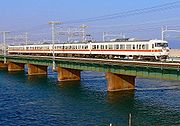
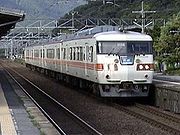 Immediately after the privatization of JNR, the 117 series was JR Central's primary workhorse. However, replacement on the western Chūō West Line
Immediately after the privatization of JNR, the 117 series was JR Central's primary workhorse. However, replacement on the western Chūō West Line
by the then-new 211-5000 series
cars began in 1988, and all 117 series cars were reassigned to Ōgaki Depot. On the Tōkaidō Main Line, the 117 was replaced on special rapid service by the 313 series
. The maximum operating speed on the Tōkaidō Line was raised to 120 km/h in 1999.
As of 2007, 8-car sets are used during morning and evening rush periods between Kanayama and Maibara and during the day between Hamamatsu and Toyohashi as well as Ōgaki and Maibara, but most are stored at Ōgaki Depot, Atsuta Station, Ōbu Station, or Toyohashi Station
.
Interiors have had longitudinal seats installed at the ends of the cars and directly behind the driver's station.
From October 2006, midday operation between Ōgaki and Maibara makes up the majority of the 117 series' use by JR Central.
From March 2008, departures from Okazaki Station on special rapid service have increased.
From about 1999, all cars appeared in a simplified version of their previous livery. A single, thick orange stripe below the windows replaced a thin stripe on the rain gutter along the sides of the roof, a thick orange band below the windows, and a thin orange band immediately below that. The headboard, which originally had rapid written in yellow on a white background, had a black border added to its lettering to ease reading.
Electric multiple unit
An electric multiple unit or EMU is a multiple unit train consisting of self-propelled carriages, using electricity as the motive power. An EMU requires no separate locomotive, as electric traction motors are incorporated within one or a number of the carriages...
introduced in 1979 by Japanese National Railways
Japanese National Railways
, abbreviated or "JNR", was the national railway network of Japan from 1949 to 1987.-History:The term Kokuyū Tetsudō "state-owned railway" originally referred to a network of railway lines operated by nationalized companies under the control of the Railway Institute following the nationalization...
(JNR), and currently operated by Central Japan Railway Company
Central Japan Railway Company
The is the main railway company operating in the Chūbu region of central Japan. It is officially abbreviated in English as JR Central and in Japanese as . Its headquarters are located in the JR Central Towers in Nakamura-ku, Nagoya, Aichi Prefecture.The company's operational hub is Nagoya Station...
(JR Central) and West Japan Railway Company
West Japan Railway Company
, also referred to as , is one of the Japan Railways Group companies and operates in western Honshū. It has its headquarters in Kita-ku, Osaka.-History:...
(JR West). A total of 216 cars were manufactured. When JNR was privatized and divided into the individual JR Group companies, JR Central received 72 cars, while JR West took possession of 144.
Features
The 117 series was first introduced to replace the 113 series113 series
The is a Japanese suburban electric multiple unit train type introduced in 1963 by Japanese National Railways , currently operated by Central Japan Railway Company , West Japan Railway Company , and Shikoku Railway Company , and formerly also operated by East Japan Railway Company .The design was...
trains that had been providing special rapid service in the Keihanshin region on the Tōkaidō Main Line
Tokaido Main Line
The is the busiest trunk line of the Japan Railways Group , connecting Tōkyō and Kōbe stations. It is long, not counting its many freight feeder lines around the major cities...
and Sanyō Main Line. 113 series cars were used in this role from 1972 along with 153 series express cars that been surplussed as a result of the opening of the Sanyō Shinkansen
Sanyō Shinkansen
The is a line of the Japanese Shinkansen high-speed rail network, connecting Shin-Ōsaka in Osaka with Hakata Station in Fukuoka, the two largest cities in western Japan...
to Okayama. Although 113 series cars were run in place of 153 series cars, the two were not entirely similar; the 153s had been retrofitted with air conditioning, but their traction motors (MT46 type, producing 100 kW @ 375 V), first built in 1958, were underpowered and the interior had box seats while cars run on competing services by the Hankyu Railway
Hankyu Railway
is a Japanese private railway that provides commuter and interurban service to the northern Kansai region and is one of major businesses operated by Hankyu Hanshin Holdings, Inc. The railway's main terminal is at Umeda Station in Osaka...
and Keihan Railway had cross seats. And, as they were designed for express service, they had entryways which required passengers to step up onto the main floor—unsuitable during peak commuter times.
The 117 series addressed these issues, matched the passenger accommodations offered by competing services, and provided JNR with a train designed for the transit conditions in the Keihanshin region. The interior was based on the KiHa 66/67 series DMU
Diesel multiple unit
A diesel multiple unit or DMU is a multiple unit train consisting of multiple carriages powered by one or more on-board diesel engines. They may also be referred to as a railcar or railmotor, depending on country.-Design:...
s being operated in the Kita Kyushu region. This also marked the beginning of JNR's effort to standardize their rolling stock.
In 1982, 153 series trains serving rapid service in the Nagoya area were replaced with 117 series trains which began duty on the Tokai Liner service.
Consists
The 117 series was designed to be operated in 6-car consists, with a 2:1 ratio of powered cars to trailer cars. At the time of development, this was JNR's standard configuration. In later years, 4-car consists with a powered car to trailer car ratio of 1:1 and 8-car consists with a ratio of 3:1 were organized. The 117 series has no intermediate trailer cars.| KuHa117 | MoHa117 | MoHa116 | MoHa117 | MoHa116 | KuHa116 |
| Tc | M | M' | M | M' | Tc' |
| KuHa117 | MoHa117 | MoHa116 | KuHa116 |
| Tc | M | M' | Tc' |
| KuHa117 | MoHa117 | MoHa116 | MoHa117 | MoHa116 | MoHa117 | MoHa116 | KuHa116 |
| Tc | M | M' | M | M' | M | M' | Tc' |
- KuHa117 - Trailer car with motorman's station, west-facing.
- MoHa117 - Powered car with pantograph and electrical apparatus to be used as a set with a MoHa116 car.
- MoHa116 - Powered car with motor-generator and compressor to be used as a set with a MoHa117 car.
- KuHa116 - Trailer car with motorman's station, east-facing.
Construction
This information pertains to the 0 sub-series.On September 12, 1979, the first 6-car set emerged from Kawasaki Heavy Industries
Kawasaki Heavy Industries Rolling Stock Company
is the rolling stock production division of Kawasaki Heavy Industries. Since beginning operations in 1906, the company has produced more than 90,000 railroad vehicles.- Products :...
' Hyōgo Works. After trial runs, it was displayed at Ōsaka, Kyōto, Kōbe, and Himeji on October 13 and 14. The sets' completion dates and manufacturers are as follows:
| set | | completion date | | manufacturer |
|---|---|---|
| 1 | September 12, 1979 | Kawasaki Heavy Industries |
| 2 | January 29, 1980 | Kawasaki Heavy Industries |
| 3 | January 29, 1980 | Kawasaki Heavy Industries |
| 4 | January 12, 1980 | Kinki Sharyō |
| 5 | February 5, 1980 | Kinki Sharyō |
| 6 | February 5, 1980 | Kinki Sharyō |
| 7 | February 26, 1980 | Kawasaki Heavy Industries |
| 8 | March 13, 1980 | Kinki Sharyō |
| 9 | April 22, 1980 | Nippon Sharyō |
| 10 | April 22, 1980 | Nippon Sharyō |
| 11 | July 8, 1980 | Nippon Sharyō |
| 12 | July 8, 1980 | Nippon Sharyō |
| 13 | April 8, 1980 | Kawasaki Heavy Industries |
| 14 | April 8, 1980 | Kawasaki Heavy Industries |
| 15 | June 3, 1980 | Kawasaki Heavy Industries |
| 16 | June 3, 1980 | Kawasaki Heavy Industries |
| 17 | June 17, 1980 | Kawasaki Heavy Industries |
| 18 | June 17, 1980 | Kawasaki Heavy Industries |
| 19 | May 14, 1980 | Kinki Sharyō |
| 20 | May 14, 1980 | Kinki Sharyō |
| 21 | July 15, 1980 | Kinki Sharyō |
Carbody
The 117 series trains have 20 meter long corrosion-resistant steel bodies with 2 sets of semi-automatic double doors per side (Nagoya-area cars have fully automatic doors). The body sides are similar to those of JNR KiHa 66 DMUs and Hankyū 2800 series trains, while the front resembles that of the JNR 157 series. It differs in that the 157 had single headlights while the 117 has two per side, and the 117 features a built-in classification headboard directly below the windshield's center post. (The 185 series185 series
The is an EMU operated by East Japan Railway Company primarily on middle-distance limited express services centering on Tokyo.The class is broadly divided into two variants: 185-0 series for use south-west of Tokyo, and 185-200 series originally for use north of Tokyo.-185-0 series:The 185 series...
is the only other type to have this appearance.)
The 117's original livery was creme with a thin, horizontal maroon band below the windows. The history of this scheme includes the 52 series
52 series
The EMUs were manufactured in 1936-1937 in 3 batches and operated by Japanese Government Railways for use on the Hanwa Line, and later used on the San'yō Main Line, JR Kobe Line, JR Kyoto Line in the Kansai region and the Iida Line in Nagano Prefecture, Japan...
Express trains as well as the 80 series trains built in the 1950s, and was chosen due to its fitting in with other liveries used by the Ōsaka Railway Administration. It had been a JNR rule that suburban train liveries were consistent from train to train based on their use of either AC or DC current, however the 117 series broke that rule. Later, the 105 series trains inaugurated the use of liveries based on region.

Air conditioning was via JNR's standard AU75B and AU75C units situated in the center of the roof (42,000kcal/h. B is used on trailer cars with driver's station, C on powered cars. 100 sub-series cars were upgraded to AU75E). Like on the 183 series, these units could also circulate fresh air.
Major components
The 117 series featured many standard components of the era, however due to its surpassing the typical operating speed of 100 kilometre per hour, it also employed higher quality components.Traction motors
The 117 series uses type MT54D traction motors (rated at 120 kW @ 375 V). A common JNR unit of the time, it was also used in 113 series trains. The 117 also had JNR's standard final drive ratio, 4.82:1. Having the same acceleration rate as the 113 series and 115 series115 series
The is a DC electric multiple unit train type developed by Japanese National Railways and now operated by East Japan Railway Company , West Japan Railway Company , and the Shinano Railway.-JR East:...
, 6-car consists with four powered and two trailer cars were not quite as strong as those in use in comparable services by competing private railways. The difference in 4-car consists with only two powered cars was even more pronounced.
Train control
Equipped with the CS43A control gear also in use on the 381 series381 series
The is a tilting DC electric multiple unit introduced in 1973 by Japanese National Railways , and currently operated by West Japan Railway Company , and formerly also operated by Central Japan Railway Company in Japan.-JR West:...
and 417 series, the 117 series included a retarder to maintain speed on an incline. While the CS12 control gear in the 113 series and 153 series and the CS15 control gear in the 115 series and 165 series had been improved to provide smoother acceleration, the CS43A, which was brand new at the time, was chosen.

Bogies
Two types of bogies were considered for the 117 series before a third was chosen. The high-speed DT24 air spring bogies from the 153 series were considered but passed over, as were the DT21 coil spring trucks, standard at the time. Ultimately, the 117 series was equipped with DT32E bogies on the powered cars and TR69H bogies on the trailers.Pantograph
The 117 series uses the standard PS16 pantograph, however for resistance to the effects of cold weather conditions and snow encountered when running on the Kosei Line, the PS16J variant is used.Couplers
Standard JNR Shibata-type couplers are used on the 117 series, but like on the 153 series, automatic electrical couplers were added to ease lash-up operations when creating 12-car consists for rush hour. Based on the success of this equipment, 221 series221 series
The is a suburban electric multiple unit operated by West Japan Railway Company in the Kansai Region of Japan.-8-car sets:-6-car sets:-4-car sets:-8-car sets:-6-car sets:-4-car sets:-2-car sets:-4-car sets:...
and 223 series
223 series
The is a suburban electric multiple unit train type operated by West Japan Railway Company in the Kansai Region, Chūgoku region and Shikoku of Japan...
were also so equipped.
0 subseries

In 1982, nine 6-car sets entered service in the Nagoya area. These were assigned to Ōgaki Depot.
100 and 200 subseries


- Seats were added in the unused space at the ends of the cabins.
- The original side windows were replaced with units that have a single pane which closes vertically.
- The lower portion of the carbody sides were.
- Bogies were replaced with DT50C types on powered cars and TR235B types (both developed for the 205 series205 seriesThe is a commuter electric multiple unit train type introduced in 1985 by Japanese National Railways , and currently operated by East Japan Railway Company and West Japan Railway Company .- Lines on which 205 series trains operate :...
) on the trailer cars. As a result of this, the interior floor was lowered 45 mm. - Installation of contoured bench seats.
Operations
From the time of their construction until the privatization of JNR, the 117 series were the workhorses of the Keihanshin and Nagoya regions' rapid and special rapid services.Following privatization, JR West kept the cars used in the Keihanshin region while JR Central kept those used in Nagoya. Each railway's use of their 117 series trains is explained below.
From special rapid service to withdrawal and reassignment
After the arrival of the 221 series221 series
The is a suburban electric multiple unit operated by West Japan Railway Company in the Kansai Region of Japan.-8-car sets:-6-car sets:-4-car sets:-8-car sets:-6-car sets:-4-car sets:-2-car sets:-4-car sets:...
in the Keihanshin region, the maximum speed of special rapid trains was increased to 115 km/h (71.5 mph) as of the March 10, 1990, timetable. That year, all 117 series cars underwent improvement to their brakes to accommodate this new operating speed. As new 221 series cars entered service, there was an excess of 117 cars, and as the speed of most special rapid services was further increased to 120 km/h (74.6 mph), 117s were reassigned to other lines. The 300 subseries entered service on the Fukuchiyama Line
Fukuchiyama Line
The is a railway line of West Japan Railway between Osaka and Fukuchiyama, Japan. Within JR West's "Urban Network" covering the Osaka-Kobe-Kyoto metropolitan region, the line from Osaka to Sasayamaguchi is also called the JR Takarazuka Line...
, while shortened consists began running on the Nara Line
Nara Line
The is a commuter rail line in the Osaka-Kobe-Kyoto metropolitan area, operated by the West Japan Railway Company . Its official termini are Kizu Station in Kizugawa and Kyōto Station in Kyoto, within Kyoto Prefecture; however, all trains continue past Kizu on the Yamatoji Line to Nara Station in...
, Kosei Line
Kosei Line
The is one of commuter rail lines and services in Osaka-Kobe-Kyoto Metropolitan Area, operated by West Japan Railway Company. The line was completed in 1974 by the former Japanese National Railways to provide faster access from the Kansai region to the Hokuriku region...
, Kusatsu Line
Kusatsu Line
The is a railway line in western Japan operated by West Japan Railway Company . It connects Tsuge on the Kansai Main Line with Kusatsu on the Biwako Line .-Stations:...
, and on the Sanyō Main Line in the Okayama area on the Sunliner service. Cars which became surplus due to the shortened consists were converted into 115 series 3500 subseries. This was the first reduction in the number of 117 series cars.
117 series cars retained in special rapid service were used only in early morning and late night runs because of their 115 km/h limit and door configuration. With the appearance of the 223 series
223 series
The is a suburban electric multiple unit train type operated by West Japan Railway Company in the Kansai Region, Chūgoku region and Shikoku of Japan...
in the May 11, 1999, timetable, capable of operating at 130 km/h (80.8 mph) between Nishi-Akashi
Nishi-Akashi Station
is a Sanyō Shinkansen and Sanyō Main Line train station serving the city of Akashi, Hyōgo Prefecture, Japan. As part of the Urban Network, the J-Through Card, ICOCA, Suica, PiTaPa, TOICA and SUGOCA can all be used on the Sanyō Main Line .-Station and platforms:The Shinkansen and regular train...
and Kusatsu
Kusatsu Station
Kusatsu Station is the name of two train stations in Japan:# Kusatsu Station # Kusatsu Station...
, 117 series trains were withdrawn from special rapid service. A year later, 221 series cars were also removed from this service.
Having first appeared on special rapid service, the number of these cars has dwindled, and there are now only two 6-car sets assigned to the Kyōto Depot. After the installation of toilets (in the KuHa117 cars) and modifications to meet barrier-free requirements, they are sometimes used for reserved groups. The headboard has had the JR logo removed, and appropriately displays 'special' in the event of non-standard revenue operation. On October 10, 2004, the headboard displayed 'Revival Special Rapid' for a one-day promotional return to special rapid service.
In 2000, due to use of the newer 221 series, some 117 series trains were withdrawn from Tambaji rapid service on the Fukuchiyama Line
Fukuchiyama Line
The is a railway line of West Japan Railway between Osaka and Fukuchiyama, Japan. Within JR West's "Urban Network" covering the Osaka-Kobe-Kyoto metropolitan region, the line from Osaka to Sasayamaguchi is also called the JR Takarazuka Line...
and reassigned to Hineno Depot for operation on the Wakayama Line
Wakayama Line
The is a railway line that links Nara Prefecture to Wakayama Prefecture in Japan, operated by West Japan Railway Company . It runs from Ōji Station on the Yamatoji Line to Wakayama Station on the Hanwa Line and Kisei Main Line, with through train service to JR Namba via the Yamatoji Line and to...
. Again in 2001, 117 series cars were replaced by 221 series units on Miyako rapid service on the Nara Line. In 2005, 100 subseries intermediate cars were reassigned to the Shimonoseki Administrative Office, and later 2 sets of 300 subseries trains were also sent there to operate in the region on the Sanyō Main Line.
Due to repeated reassignment, many consists are a mixture of liveries and subseries.
Upgrade to 300 subseries


In order to increase the capacity of the cars and ease boarding and alighting, cross seats immediately inside the doors were converted to long seats. Up to this point, rush hour trains were being delayed due to the time needed for passengers to board and alight. Brakes were augmented, and the livery now associated with the Fukuchiyama Line, white with green striping, appeared. Some cars with the original seating arrangement still exist.
However, these modifications did not entirely solve the problems with passenger mobility during rush hour, and as a result, the 117-300s were used on outgoing services (bound for Fukuchiyama) and off-peak services. From April 2000, 2 4-car consists were dispatched from Hineno Depot for operation on the Wakayama Line and Kisei Main Line, and
Sets which remained on the Fukuchiyama Line until the series' complete withdrawal from the line are now assigned to Kyōto Depot for operation on the San'in Main Line
San'in Main Line
The is a railway line in western Japan that runs from Kyoto to Shimonoseki, Yamaguchi Prefecture, operated by West Japan Railway Company . It is the major railway line of the San'in region, running along the Japan Sea, crossing Kyoto, Hyōgo, Tottori, Shimane and Yamaguchi prefectures...
(Sagano Line
Sagano Line
The is the popular name for a portion of the Sanin Main Line in the suburbs of Kyoto, Japan. The electrified and double-tracked railway is a commuter rail line in the Osaka-Kobe-Kyoto Metropolitan Area, owned and operated by West Japan Railway Company . The line starts at Kyoto Station and ends at...
), Kosei Line, and Kusatsu Line, among others. Some consists have ATS-P train control onboard, others have MoHa cars surplussed by the creation of shorter 100 subseries sets.
- 300 subseries renumbering
- MoHa117/116-3 - 16, 19, 20, 41, 42 → MoHa117/116-303, 316, 319, 320, 341, 342
- KuHa117/116-2 - 8, 10, 18, 20, 10 → KuHa117/116-302, 308, 310, 318, 320, 321
Reassignment to the Okayama Area

-
- E1: KuHa117-9 - MoHa117-18 - MoHa116-18 - KuHa116-9
- E2: KuHa117-11 - MoHa117-22 - MoHa116-22 - KuHa116-11
- E3: KuHa117-13 - MoHa117-26 - MoHa116-26 - KuHa116-13
- E4: KuHa117-15 - MoHa117-30 - MoHa116-30 - KuHa116-15
- E5: KuHa117-17 - MoHa117-34 - MoHa116-34 - KuHa116-17
- E6: KuHa117-19 - MoHa117-38 - MoHa116-38 - KuHa116-19
Later, three 4-car sets were borrowed from the Miyahara Depot and designated E11, E12, and E13. These were used in the region on local services and also served as the primary units for Sunliner rapid service. These were run as far north as the Yonago area for special services during periods of high ridership. 100 subseries cars at the Okayama Depot without upgraded lavatories were mothballed at the Gotō Depot in Yonago until reassignment to Shimonoseki in October 2005.
- 3500 subseries renumbering
- MoHa117/116-17, 21, 23, 25, 27, 29, 31, 33, 35, 37, 39, 303, 315, 316 → MoHa115/114-3501 - 3514
Reassignment to Kisei Main Line and Wakayama Line

In March 2001, the 117 series trains assigned to Miyahara Depot were removed from the Nara Line
Nara Line
The is a commuter rail line in the Osaka-Kobe-Kyoto metropolitan area, operated by the West Japan Railway Company . Its official termini are Kizu Station in Kizugawa and Kyōto Station in Kyoto, within Kyoto Prefecture; however, all trains continue past Kizu on the Yamatoji Line to Nara Station in...
's Miyakoji rapid service. One 6-car set from Miyahara Depot was reassigned to Hineno Depot as G803 and used to replace 113 series units out of service for inspection. In December of the same year, 2 surplus 300 subseries end cars and 2 MoHa units not in the G803 set were modified for driver-only operation and painted ocean green with a lavender stripe. These entered service as G804 in January 2002. Subsequently, all 117 sets received the same treatment.
In March 2002, Miyahara Depot's 4-car set C12 was returned from Shimonoseki to Hineno, and the inventory of five 4-car sets was complete. At this time, the operating area of the Hineno Depot 117s was enlarged on the Hanwa Line from Hineno Station to Wakayama Station, and on the Kisei Main Line from Wakayama Station to Kii-Tanabe Station. All trainsets were operated without conductors and had the ocean green and lavender Wakayama livery. However, as the doors were not configured to be opened independently of one another, it was believed that it would be easy to sneak onto the trains at unmanned stations. For this reason, special conductors were put on board to check tickets.
In November 2002, after reassignment to Shin-Wakayama Depot, they were removed from service on the Hanwa Line
Hanwa Line
The is one of commuter rail lines and services in Osaka-Kobe-Kyoto Metropolitan Area, owned and operated by West Japan Railway Company. The line runs between Osaka and Wakayama, Japan and has a 1.7-kilometre branchline in Osaka suburb....
and on the Kisei Main Line between Gobo and Kii-Tanabe. In August 2008, they were transferred back to Hineno Depot and are currently operating on the Wakayama Line. When Hineno 113 series trains are unavailable due to inspection schedules, 117 series trains fill in on the Kisei Main Line. 221 series trains from Nara Depot are used to provide yet more service in such situations.
- 117 series trains operating on the Kisei Main Line and Wakayama Lines are classified as:
- G1(G805): KuHa117-12 - MoHa117-24 - MoHa116-24 - KuHa116-12
- G2(G803): KuHa117-14 - MoHa117-28 - MoHa116-28 - KuHa116-14
- G3(G804): KuHa117-308 - MoHa117-40 - MoHa116-40 - KuHa116-308
- G4(G801): KuHa117-318 - MoHa117-305 - MoHa116-305 - KuHa116-318
- G5(G802): KuHa117-320 - MoHa117-341 - MoHa116-341 - KuHa116-320
-
-
- Numbers in parentheses were used by Hineno Depot until March 2002
-
JR Central


Chuo Main Line
The , commonly called the Chūō Line, is one of the major trunk railway lines in Japan. It runs between Tokyo and Nagoya, although it is the slowest direct railway connection between the two cities; the coastal Tōkaidō Main Line is slightly faster, while the Tōkaidō Shinkansen is the fastest rail...
by the then-new 211-5000 series
211 series
The is a suburban electric multiple unit train type introduced in 1985 by Japanese National Railways , and currently operated by East Japan Railway Company and Central Japan Railway Company and formerly also operated by West Japan Railway Company in Japan.-Design:The 211 series was developed by...
cars began in 1988, and all 117 series cars were reassigned to Ōgaki Depot. On the Tōkaidō Main Line, the 117 was replaced on special rapid service by the 313 series
313 series
The is a DC suburban electric multiple unit train operated by Central Japan Railway Company in Japan.The design was introduced from spring 1999 to replace older 113 and 115 series EMUs.-Variants:-313-0 series:...
. The maximum operating speed on the Tōkaidō Line was raised to 120 km/h in 1999.
As of 2007, 8-car sets are used during morning and evening rush periods between Kanayama and Maibara and during the day between Hamamatsu and Toyohashi as well as Ōgaki and Maibara, but most are stored at Ōgaki Depot, Atsuta Station, Ōbu Station, or Toyohashi Station
Toyohashi Station
is an interchange railway station in Toyohashi, Aichi Prefecture, Japan, on the Tōkaidō Shinkansen, Tōkaidō Main Line, Iida Line, and is a terminus of the...
.
Interiors have had longitudinal seats installed at the ends of the cars and directly behind the driver's station.
From October 2006, midday operation between Ōgaki and Maibara makes up the majority of the 117 series' use by JR Central.
From March 2008, departures from Okazaki Station on special rapid service have increased.
From about 1999, all cars appeared in a simplified version of their previous livery. A single, thick orange stripe below the windows replaced a thin stripe on the rain gutter along the sides of the roof, a thick orange band below the windows, and a thin orange band immediately below that. The headboard, which originally had rapid written in yellow on a white background, had a black border added to its lettering to ease reading.
Preserved examples
- KuHa 117-30 + MoHa 116-59 + KuHa 116-209: At SCMaglev and Railway Park, Nagoya (displayed outside)

